
Dame Millicent Garrett Fawcett was an English politician, writer and feminist. She campaigned for women's suffrage by legal change and in 1897–1919 led Britain's largest women's rights association, the National Union of Women's Suffrage Societies (NUWSS), explaining, "I cannot say I became a suffragist. I always was one, from the time I was old enough to think at all about the principles of Representative Government." She tried to broaden women's chances of higher education, as a governor of Bedford College, London and co-founding Newnham College, Cambridge in 1875. In 2018, a century after the Representation of the People Act, she was the first woman honoured by a statue in Parliament Square.

The National Union of Women Suffrage Societies (NUWSS), also known as the suffragists was an organisation founded in 1897 of women's suffrage societies around the United Kingdom. In 1919 it was renamed the National Union of Societies for Equal Citizenship.
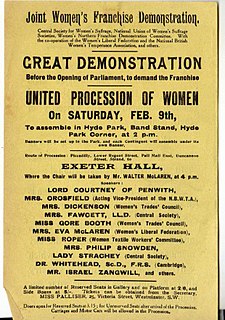
The United Procession of Women, or Mud March as it became known, was a peaceful demonstration in London on 9 February 1907 organised by the National Union of Women's Suffrage Societies (NUWSS), in which more than three thousand women marched from Hyde Park Corner to the Strand in support of women's suffrage. Women from all classes participated in what was the largest public demonstration supporting women's suffrage seen up to that date. It acquired the name "Mud March" from the day's weather, when incessant heavy rain left the marchers drenched and mud-spattered.

The Women Writers' Suffrage League (WWSL) was an organisation in the United Kingdom formed in 1908 by Cicely Hamilton and Bessie Hatton. The organisation stated that it wanted "to obtain the Parliamentary Franchise for women on the same terms as it is, or may be, granted to men. Its methods are the methods proper to writers – the use of the pen." The organisation viewed itself as a writers' group rather than a literary society. Membership was not based on literary merit, but instead was granted to anyone who had published and sold a written work. Members also paid an annual subscription fee of 2s. 6d. The league was inclusive and welcomed writers of all genders, classes, genres, and political persuasions provided they were pro-suffrage. By 1911 the league was composed of conservatives, liberals and socialists, women of power and women who worked hard and members of the military. The league disbanded on 24 January 1919 following the passing Representation of the People Bill in February 1918, granting women over the age of 30 the right to vote.
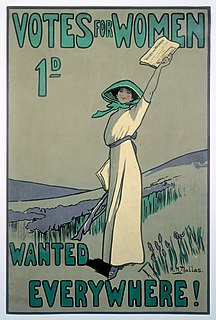
A movement to fight for women's right to vote in the United Kingdom finally succeeded through laws in 1918 and 1928. It became a national movement in the Victorian era. Women were not explicitly banned from voting in Great Britain until the Reform Act 1832 and the Municipal Corporations Act 1835. In 1872 the fight for women's suffrage became a national movement with the formation of the National Society for Women's Suffrage and later the more influential National Union of Women's Suffrage Societies (NUWSS). As well as in England, women's suffrage movements in Wales, Scotland and other parts of the United Kingdom gained momentum. The movements shifted sentiments in favour of woman suffrage by 1906. It was at this point that the militant campaign began with the formation of the Women's Social and Political Union (WSPU).

Mary Reid Anderson was a Scottish suffragist and was a leading trades unionist. She was the general secretary of the Women's Trade Union League and was involved in the formation of the National Federation of Women Workers and National Anti-Sweating League. In 1910, Macarthur led the women chain makers of Cradley Heath to victory in their fight for a minimum wage and led a strike to force employers to implement the rise. About 1901, Macarthur became a trade unionist after hearing a speech made by John Turner about how badly some workers were being treated by their employers. Mary became secretary of the Ayr branch of the Shop Assistants' Union, and her interest in this union led to her work for the improvement of women's labour conditions. In 1902 Mary became friends with Margaret Bondfield who encouraged her to attend the union's national conference where Macarthur became the first woman to be elected to the union's national executive.
The 1913 Shrewsbury by-election was a parliamentary by-election held in England in April 1913 to elect a new Member of Parliament (MP) for the borough of Shrewsbury in Shropshire.

Women's suffrage in Canada occurred at different times in different jurisdictions and at different times to different demographics of women. Women's right to vote began in the three prairie provinces. In 1916, suffrage was earned by women in Manitoba, Saskatchewan, and Alberta. The federal government granted limited war-time suffrage to some women in 1917 and followed with full suffrage in 1918, at least, granting it on same basis as men, that is, certain races and status were excluded from voting in federal elections prior to 1960..

Helen Miller Fraser, later Moyes, was a Scottish suffragist, feminist, educationalist and Liberal Party politician who later emigrated to Australia.
The United Suffragists was a women's suffrage movement in the United Kingdom.
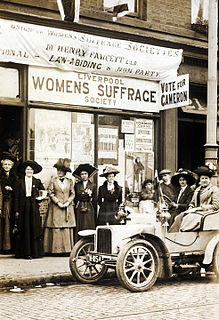
The Liverpool Women's Suffrage Society was set up in 1894 by Edith Bright, Lydia Allen Booth and Nessie Stewart-Brown to promote the enfranchisement of women. The society held its first meeting in a Liverpool temperance hall, with Millicent Fawcett, head of the National Union of Women's Suffrage Societies (NUWSS), as its guest speaker. The society set up headquarters in Lord Street. The group became affiliated with the NUWSS in 1898, it held meetings in cafés which included talks, poetry and dance recitals. Members were recruited from prominent members of society and they distanced themselves from working class suffrage societies such as Women's Social and Political Union (WSPU).

Women's suffrage in Wales has historically been marginalised due to the prominence of societies and political groups in England which led the reform for women throughout the United Kingdom. Due to differing social structures and a heavily industrialised working-class society, the growth of a national movement in Wales grew but then stuttered in the late nineteenth century in comparison with that of England. Nevertheless, distinct Welsh groups and individuals rose to prominence and were vocal in the rise of suffrage in Wales and the rest of Great Britain.
This is an overview of Women's Suffrage activism and local politics as experienced in Leigh, Lancashire between 1900 and 1914.
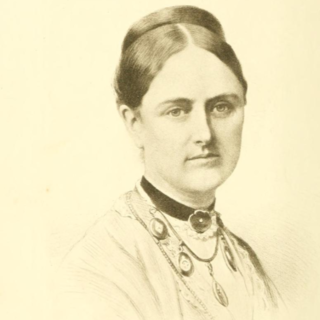
Louisa Mary Knightley, Lady Knightley was a British Anglican and women's rights activist.
Ellen Chapman was an English suffragist and local politician, and the first woman councillor for Worthing.
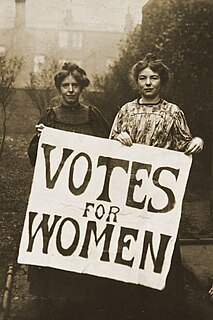
The Historiography of the Suffragette Campaign deals with the various ways Suffragettes are depicted, analysed and debated within historical accounts of their role in the campaign for women's suffrage in early 20th century Britain.
Mary Fox-Strangways, Countess of Ilchester was an Anglo-Irish noblewoman and leading figure in London society. She was the wife of Henry Fox-Strangways, 5th Earl of Ilchester.

Edith Mary Sutton (1862–1957) was the first woman to become a councillor in England, the first female Mayor in Reading, and a suffragist.
Alice Low, (1877–1954) was a British suffragist, who spoke up for peaceful means of achieving women's rights to vote, and fairer laws, including reducing sweated labour. She was a leader in Edinburgh and Berwickshire National Union of Women's Suffrage Societies (NUWSS) and a touring speaker in the early twentieth century. She was also a lead member of Queen Mary's Army Auxiliary Corps. (QMAAC) in World War One and an amateur actress taking lead roles with the British Empire Shakespearean Society.













